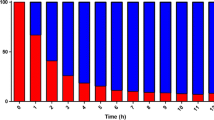Abstract
Purpose. The use of intracerebral microdialysis as a tool to measure the penetration of anticancer agents in brain tumor was investigated.
Methods. Following intravenous (iv) administration of 75 mg/kg. concentration-time profiles of methotrexate (MTX) were determined in brain cortical dialysate and in plasma. The individual ratio of the area under the curve of MTX in brain dialysate over that in plasma (MTX penetration) was determined in normal brain, in tumor-bearing brain and in brain after sham tumor implantation. Individual brains were examined histologically on the presence of tumor, as well as for other factors that might influence local MTX penetration. Histological scores were related to the individual data on penetration of MTX.
Results. MTX penetration values were higher in cortical brain at the site of the tumor, as compared to the levels measured in normal or sham implanted brain (mean increase to 250 %). In the cortical brain contralateral to the tumor, MTX penetration values were found to be lower than in normal brain (mean reduction of 65 %). Furthermore, it appeared that in the absence of tumor tissue, the presence of exudate around the probe was independently associated with increased penetration of MTX into the brain.
Conclusions. Tumor tissue appeared to be the most important parameter in changing local MTX penetration in brain after tumor implantation. In general, it is anticipated that intracerebral microdialysis combined with histological examination can be used to investigate effects of brain tumor presence on regional (periprobe) penetration of anticancer drugs into the brain.
Similar content being viewed by others
REFERENCES
R.G. Blasberg, D. Groothius, and P. Molmar. Application of quantitative autoradiographic measurements in experimental brain tumor models. Sem. Neurol., 1:203–221 (1981).
D.R. Groothius, P. Molnar, and R.G. Blasberg. Regional blood flow and blood-to-tissue transport in five brain tumor models. Prog. Exp. Tumor Res., 27:132–153 (1984).
H. Hasegawa, Y. Ushio, T. Hayakawa, K. Yamada, and H. Mogami. Changes of the blood-brain barrier in experimental metastatic brain tumors. J. Neurosurg., 59:304–310 (1983).
W.R. Shapiro. Chemotherapy, animal models: blood-brain barrier and pharmacology. Prog. Exp. Tumor Res. 29:116–121 (1985).
N.H. Greig. Optimizing drug delivery to brain tumors. Cancer Treatment Rev., 14:1–28 (1987).
D. Zagzag, S. Brem, and F. Robert. Neovascularization and tumor growth in the rabbit brain. A model for experimental studies of angiogenesis and the blood-brain barrier. Am. J. Pathol., 131:361–372 (1988).
L. Stahle. The use of microdialysis in pharmacokinetics and pharmacodynamics. In T.E. Robinson and J.B. Justice (eds) Microdialysis in Neuroscience, Elsevier Science Publishers B.V., 1991, pp 155–174.
E.C.M. de Lange, M. Danhof, A.G. de Boer, and D.D. Breimer. Critical factors of intracerebral microdialysis as a technique to determine the pharmacokinetics of drugs in the brain. Brain Res., 666:1–8 (1994).
E.C.M. de Lange, M.B. Hesselink, M. Danhof, A.G. de Boer, and D.D. Breimer. The use of intracerebral microdialysis to determine changes in blood-brain barrier transport characteristics. Pharm Res., 12:129–133 (1995).
E.C.M. de Lange, M.R. Bouw, J.W. Mandema, M. Danhof, A.G. de Boer, and D.D. Breimer. Application of intracerebral microdialysis to study regional distribution kinetics of drugs in rat brain. Br. J. Pharm., accepted for publication (1995).
G.W. Barendsen and J.J. Broerse. Experimental radiotherapy of a rat rhabdomyosarcoma with 15 MeV neutrons and 300 kV X-rays-I. Effects of single exposures. Eur. J. Cancer, 5:373–391 (1969).
B. Moghaddam and B.S. Bunney. Ionic composition of microdialysis perfusing solution on pharmacological responsiveness and basal outflow of striatal dopamine. J. Neurochem., 53:652–654 (1989).
D.R. Groothuis, J.M. Fischer, G. Lapin, D.D. Bigner and N.A. Vick. Permeability of different experimental brain tumor models to horseradish peroxidase. J. Neuropathol. Exp. Neurol., 41:164–185 (1982).
W.R. Shapiro and J.R. Shapiro. Principles of brain tumor chemotherapy. Sem. Oncol., 13:56–69 (1986).
N.A. Vick, J.D. Khandekar and D.D. Bigner. Chemotherapy of brain tumors: the ‘blood-brain barrier’ is not a factor. Arch. of Neurol., 34:523–526 (1977).
C. Cordon-Cardo, J.P. O'Brien, D. Casals, L. Rittman-Grauer, J.L. Biedler, M.R. Melamed, and J.R. Bertino. Multidrug-resistance gene (P-glycoprotein) is expressed by endothelial cells at blood-brain barrier sites. Proc. Natl. Acad. Sci. USA, 86:695–698 (1989).
A.H. Schinkel, J.J.M. Smith, O. van Tellingen, J.H. Beijnen, E. Wagenaar, L. van Deemter, C.A.A.M. Mol, M.A. van der Valk, E.C. Robanus-Maandag, H.P.J. te Riele, A.J.M. Berns, and P. Borst. Disruption of mouse mdrla P-glycoprotein gene leads to a deficiency in the blood-brain barrier and to increased sensitivity to drugs. Cell, 77:491–502 (1994).
I.B. Roninson. Molecular mechanism of multidrug resistance in tumor cells. Clin. Physiol. Biochem., 5:140–151 (1987).
L.J. Nugent, and R.K. Jain. Pore and fiber-matrix models for diffusive transport in normal and neoplastic tissues. Microvasc. Res., 28:270–274 (1984).
W.M. Pardridge. Overview of blood-brain barrier transport biology and experimental methodologies. In W.M. Pardridge (ed) Peptide Drug Delivery to the brain, Raven Press, New York, 1991, pp 52–98
E.A. Neuwelt, P.A. Barnett, D. Bigner, and E.P. Frenkel. Effects of adrenocortical steroids and osmotic blood-brain-barrier opening on methotrexatre delivery to gliomas in the rodent. Proc. Natl. Acad. Sci. 79:4420–4423 (1982)
E.A. Neuwelt, E.P. Frenkel, and A.N. D'Agostino. Growth of human lung tumor in the brain or nude rats as a new model to evaluate antitumor agent delivery across the blood-brain barrier. Cancer Res., 45:2827–2833 (1985)
W.R. Shapiro, R.M. Voorhies, E.M. Hiesinger, P.B. Sher, G.A. Basler, and L.E. Lipschutz. Pharmacokinetics of tumor cell exposure to 14C-methotrexate after intracarotid administration without and with hyperosmotic opening of the blood-brain and blood-tumor barriers in rat brain tumors: A quantitative autoradiographic study. Cancer Res., 48:694–701 (1988).
Rights and permissions
About this article
Cite this article
de Lange, E.C.M., de Vries, J.D., Zurcher, C. et al. The Use of Intracerebral Microdialysis for the Determination of Pharmacokinetic Profiles of Anticancer Drugs in Tumor-Bearing Rat Brain. Pharm Res 12, 1924–1931 (1995). https://doi.org/10.1023/A:1016239822287
Issue Date:
DOI: https://doi.org/10.1023/A:1016239822287




